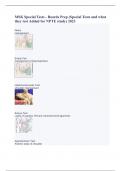10/19/24, 7:37 PM PSY 368 FINAL EXAM AND PRACTICE EXAM COMPLETE 120 QUESTIONS AND CORRECT DETAILED ANSWERS|ALREAD…
PSY 368 FINAL EXAM AND PRACTICE EXAM
COMPLETE 120 QUESTIONS AND CORRECT
DETAILED ANSWERS|ALREADYGRADED A+
Terms in this set (123)
- analytic: needs to address threat, vulnerability, and
consequences
what three characteristics
should a terror alert - deliberative: need to include transparency in values/
include, according to judgments. discussions
Willis ( 2006) ?
- practical: multiple data collection & analysis
procedures
- provide government, authorities, & public
What was the stated information about current terrorism risk
purpose of the HSAS ? - create common lanugage for discussing risk
- facilitate decision- making in private & public sectors
green:
how did the HSAS convey
- low risk of terrorist attacks
terrorism threat
- low threat
information? what were
- refine & organize procedures for potential terrorist
the levels of green, and
attacks
what were the
e.g. emergency plans, shelters, first aid/ CRP courses,
recommended actions at
etc.
each level?
never use this
https://quizlet.com/959493585/psy-368-final-exam-and-practice-exam-complete-120-questions-and-correct-detailed-answersalreadygraded-a-flash-c… 1/26
,10/19/24, 7:37 PM PSY 368 FINAL EXAM AND PRACTICE EXAM COMPLETE 120 QUESTIONS AND CORRECT DETAILED ANSWERS|ALREAD…
- general risk of terrorist attacks
- guarded threat
what were the levels of
- review & update emergency responses, provide
Blue
public with helpful info.
- never use this
- significant risk of terrorist attacks
what were the levels of - elevated threat( see more govt. action)
Yellow - increased surveillance of key locations, coordinate
emergency responses
- high level
- close collaboration between federal/ state/ local
what were the levels of law enforcement ( and military) a prep for quick action
organge - extra caution at public events, consider alternatives
- travel warnings ( delays & restrictions)
- spent a lot of time at this level
- severe level
what were the levels of - emergency personnel dispatched to key locations,
red monitoring of transportation readiness to close down
public/ govt. facilities
what are the advantages - well-intentioned ( warn the unsuspecting)
of the HSAS - simple to understand
- yellow to orange -> increased physiological arousal,
anxiety, depression
- mentally ill, disabled, african Americans, latino,
Chinese americans, Korean Americans, non-US citizen
all perceived higher risk levels than white, healthy
what were the
controls
disadvantages of the
- overstimulated threat-> stronger physiological/
HSAS
psychosocial reactions -> avoidance behaviors
- chronic fear & anxiety -> more chronic medicate
conditions, cardiac events, more substance abuse
- lots of negative health outcomes, especially for
some population
https://quizlet.com/959493585/psy-368-final-exam-and-practice-exam-complete-120-questions-and-correct-detailed-answersalreadygraded-a-flash-c… 2/26
, 10/19/24, 7:37 PM PSY 368 FINAL EXAM AND PRACTICE EXAM COMPLETE 120 QUESTIONS AND CORRECT DETAILED ANSWERS|ALREAD…
what is an National communicate gender terrorism-related info
Terrorism Advisory System a. not necessarily a direct threat to US, but info that
( NTAS) bulletin may be helpful to law enforcement, etc
- specific, creditable information about a terrorist
threat against the US
- info about threat, targeted geographic region, mode
What is an NTAS alert ? of transportation, infrastructure potentially affected,
etc
- steps for individuals and communities to protect
themselves, prevent/ mitigate/ respond to threat
elevated alert: credible threat, but only general info.
what is the difference about timing, target, etc.
between an elevated alert
and an imminent alert? imminent alert: credible, specific threat info. and
believed to be impending
fear: appraisals of uncertainty, situational control (
How do fear and anger negative)
differ when it comes to
risk appraisal? anger: appraisals of certainty, individual control (
positive)
- anger= most dominant emotion
- men more optimistic than women
- anger -> lower risk estimate-> fewer plans for
responding to future attacks ( more support for
What do these different vengeful deportation policy, less support for
effects on risk appraisal conciliatory policy
predict about people's
counterterrorism - fear-> higher risk estimate-> more plans for
preferences? responding to future attacks ( less support for
vengeful deportation policy, more support for
conciliatory policy)
- anger triggered optimism, while fear triggered
pessimism
https://quizlet.com/959493585/psy-368-final-exam-and-practice-exam-complete-120-questions-and-correct-detailed-answersalreadygraded-a-flash-c… 3/26





